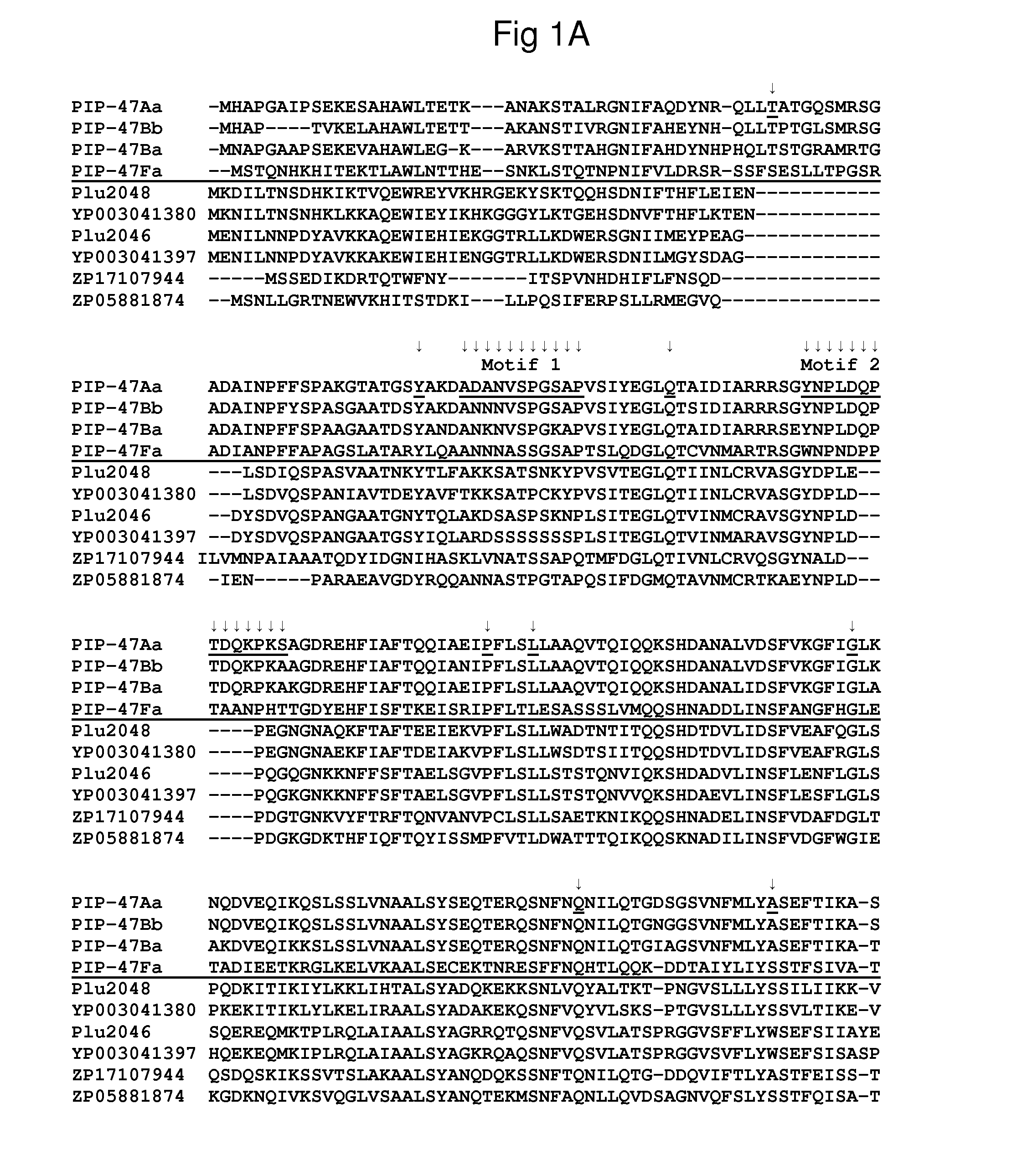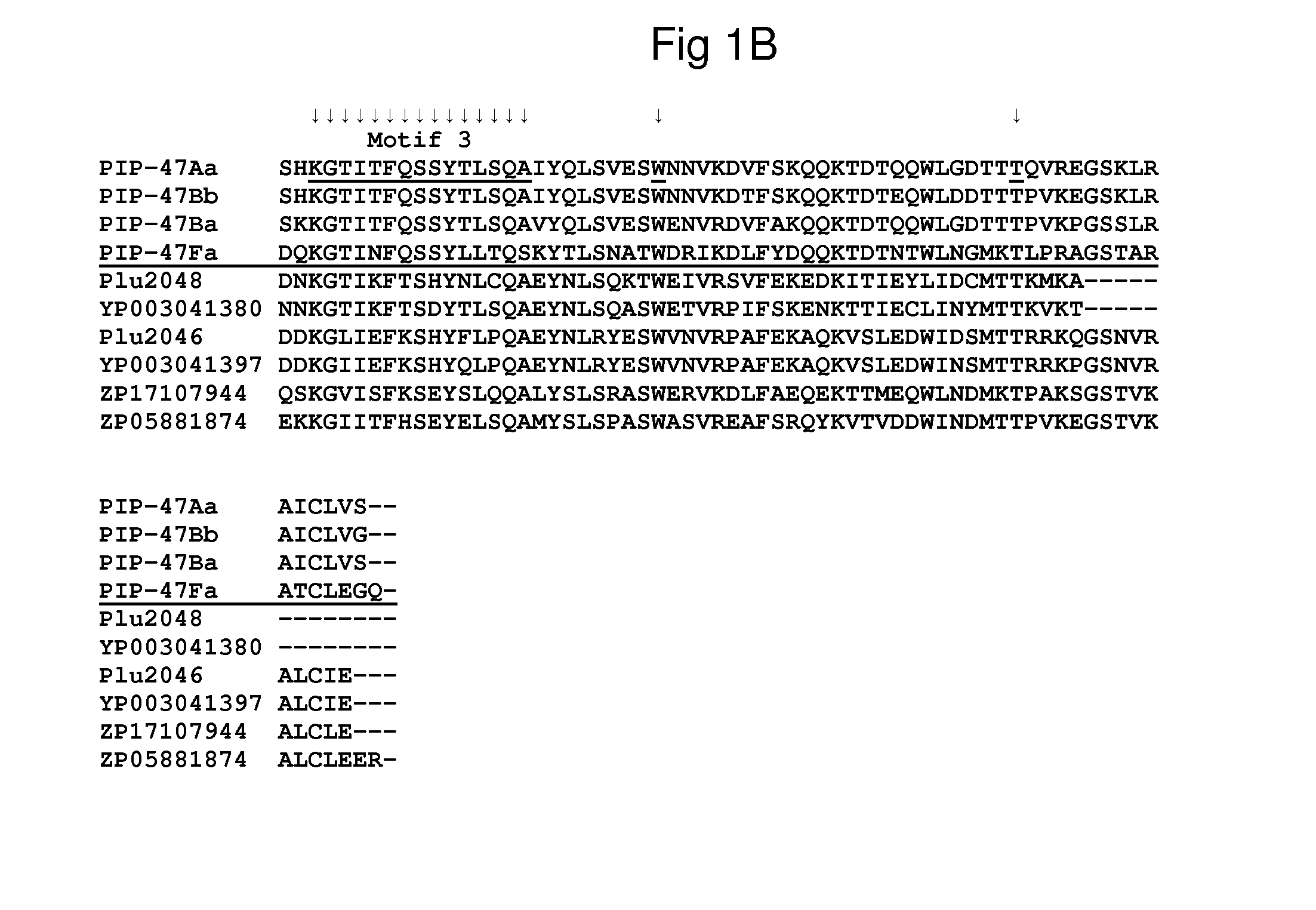Insecticidal proteins and methods for their use
a technology of insecticidal proteins and methods, applied in the field of molecular biology, to achieve the effect of enhancing pest resistance or toleran
- Summary
- Abstract
- Description
- Claims
- Application Information
AI Technical Summary
Benefits of technology
Problems solved by technology
Method used
Image
Examples
example 1
Identification of an Insecticidal Protein Active Against Western Corn Root Worm (WCRW) from Strain SS62E1
[0394]The WCRW (Diabrotica virgifera) insecticidal protein PIP-47Aa (SEQ ID NO: 1) was identified by protein purification, liquid chromatography mass spectrometry (LC-MS / MS) and PCR cloning from Pseudomonas putida strain SS62E1 as follows:
[0395]Pseudomonas Strain SS62E1 was grown in tryptic soy broth for 2 days at 30° C. and 250 rpm. Cells were harvested by centrifugation and cell pellets were washed once with phosphate buffered saline (PBS) before storage at −70° C. For protein extraction, cells were thawed and re-suspended in 50 mM sodium acetate buffer, pH 5 (buffer A) containing protease inhibitor cocktail V from Calbiochem®. A crude cleared lysate was obtained by passing the cells through a homogenizer at 30,000 psi, followed by centrifugation at 13,800×g for 20 min.
[0396]WCRW bioassays were conducted using 10 microliter cell lysate samples mixed with molten low-melt WCRW di...
example 2
Identification of Homologous Proteins of PIP-47Aa
[0401]Gene identities may be determined by conducting BLAST (Basic Local Alignment 20 Search Tool; Altschul, et al., (1993) J. Mol. Biol. 215:403-410; see also ncbi.nlm.nih.gov / BLAST / , which can be accessed using the www prefix) searches under default parameters for similarity to sequences contained in the publically available BLAST “nr” database (comprising all non-redundant GenBank CDS translations, sequences derived from the 3-dimensional structure Brookhaven Protein Data Bank, the last major release of the 25 SWISS-PROT protein sequence database, EMBL, and DDBJ databases. In addition to public databases internal DuPont Pioneer databases were searched. The polypeptide sequence of SEQ ID NO: 1 was analyzed.
[0402]The search identified several homologs of PIP-47Aa (SEQ ID NO: 1) having varying percent identity to PIP-47Aa (SEQ ID NO: 1). PIP-47Aa homologs designated as PIP-47Ba (SEQ ID NO: 4), PIP-47Bb (SEQ ID NO: 6) and PIP-47Fa (SEQ...
example 3
E. coli Expression of PIP-47Aa and Homologous Proteins
[0403]The PIP-47Aa gene was amplified by PCR using genomic DNA isolated from strain SS62E5 using the PIP-47Aa forward primer (SEQ ID NO: 423) and PIP-47Aa reverse primer (SEQ ID NO: 424). The resulting PCR product was DNA sequence verified and subcloned into pCOLD™-1 (Takara Bio Inc., Seta 3-4-1, Otsu, Shiga, Japan 520-2193) in frame with an N-terminal His-6 tag followed by a Factor Xa cleavage site. Nucleic acid sequences encoding the homologs PIP-47Ba (SEQ ID NO: 3), PIP-47Bb (SEQ ID NO: 5), and PIP-47Fa (SEQ ID NO: 7) were cloned in a similar manner, using their respective genomic DNA preparation as the template for PCR gene amplification and the primer pairs: SEQ ID NO: 425 / SEQ ID NO: 426; SEQ ID NO: 427 / SEQ ID NO: 428; and SEQ ID NO: 429 / SEQ ID NO: 430; respectively.
[0404]The coding sequence (SEQ ID NO: 9) for the homolog Plu2046 (SEQ ID NO: 10) was obtained through gene synthesis with compatible 5′ and 3′ ends for downstrea...
PUM
| Property | Measurement | Unit |
|---|---|---|
| nucleic acid | aaaaa | aaaaa |
Abstract
Description
Claims
Application Information
 Login to View More
Login to View More - R&D
- Intellectual Property
- Life Sciences
- Materials
- Tech Scout
- Unparalleled Data Quality
- Higher Quality Content
- 60% Fewer Hallucinations
Browse by: Latest US Patents, China's latest patents, Technical Efficacy Thesaurus, Application Domain, Technology Topic, Popular Technical Reports.
© 2025 PatSnap. All rights reserved.Legal|Privacy policy|Modern Slavery Act Transparency Statement|Sitemap|About US| Contact US: help@patsnap.com



